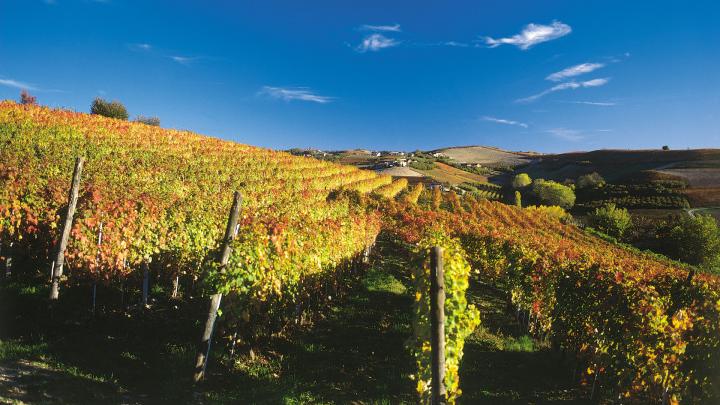Pavese wrote “Tre nasi son quel che ci vuole per bere il Barolo” (You need three noses to drink Barolo) in his “Il compagno” (The Comrade).
It is a wine that belongs to a legendary dimension. The places of origin of the grapes suitable to the making of Barolo DOCG (Protected Designation of Origin) include 11 townships: Barolo, Castiglione Falletto, Serralunga d’Alba and portions of the townships of Cherasco, Diano d’Alba, Grinzane Cavour, La Morra, Monforte d’Alba, Novello, Roddi and Verduno. This tour begins at Verduno, a town that features one of the most spectacular views of the Langa territory. Pelaverga, a fragrant red wine exclusive to this area, is also made here. Only a few steps away and you’re at La Morra: in the small town square stands a monument to the Vignaiolo d’Italia (Winemaker of Italy) and a little bit further on there is the Cantina Comunale (Town Wine Cellar). It was inaugurated in 1973 by winemakers from La Morra and wine waiters, aspiring oenologists or simple fans cannot pass up the opportunity to make a stop. The hamlet of Annunziata (Church of the Annunciation) features a Romanesque-Baroque era complex, a former Benedictine monastery, now the Chiesa dell’Annunziata . Its cellar hosts the Museo Ratti dei Vini d'Alba (Ratti Museum of Wines from Alba). From one piazza to the next: the one in Roddi is considered among the loveliest in Piemonte. The Chiesa dell’Assunta, with its late Baroque era façace, is found here along with the medieval castle, built in a position overlooking the Tanaro valley. There is a Gothic castle in Novello (homeland to the white truffle) that has been splendidly renovated. Tourists can enjoy a magnificent view of the Langhe territory and the Tanaro valley from here. Cherasco is only a handful of kilometres away. This is the city with the “starred walls” in which Gina Lagorio loved to write. Cherasco is also a destination for fans of Napoleon, since it was here that he signed the truce with the House of Savoy in 1796. Collectors also come to Cherasco where one of Italy’s most important antique market takes place, as do gourmands with a sweet tooth who can purchase the typical chocolate-hazelnut Baci di Cherasco at pastry shops in the centre of town. Monforte d’Alba is linked to the history of the Resistance in Piemonte where the priest Dallorto turned himself in to the “repubblichini” (authorities of the Salò Republic) in order to spare the town of being burned. It is in these hills that Giorgio Bocca fought as a partisan by the side of commandants Dante Livio Bianco, Ettore Rosa and Faustino Dalmazzo. The castle at Grinzane Cavour is elegant, with an outline worthy of a 19th century print. It overlooks one of the most picturesque landscapes of the Langa territory. Constructed around its central tower, the castle has been the home of the Enoteca Regionale Piemontese “Cavour” (“Cavour” Piemonte Region Wine Cellar) since 1967, a prestigious showplace of the most carefully selected wines and grappas from the region. Not far from the Vineyard of Conte Benso di Cavour, the rows of vines of Diano d’Alba are found, specialised in the production of the young and harmonious Dolcetto d’Alba wine. It is ruby coloured with a dry, fruity taste with a hint of almond. After Serralunga follows Castiglione Falletto, a land of ancient origins that celebrates “vini delle stelle” (wines of the stars) during the summer with sample sessions, local cuisine from the Langhe area, evening promenades and dissertations on astronomy.
The tour ends in Barolo, where the town and its wine are a single entity. The Enoteca Regionale del Barolo (Regional Barolo Wine Cellar) and the Museo Etnografico Enologico (Ethnographic Oenology Museum) can be visited in the castle. Guests can also relax and sip a good glass of Barolo wine. After all, it doesn’t take much to feel like a King!

